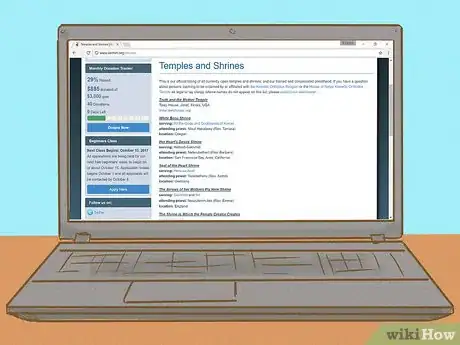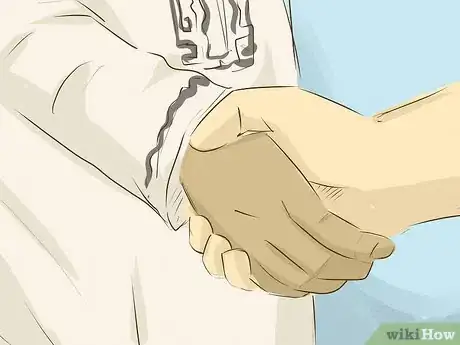This article was co-authored by wikiHow staff writer, Danielle Blinka, MA, MPA. Danielle Blinka is a Writer, Editor, Podcaster, Improv Performer, and Artist currently living in Houston, TX. She also has experience teaching English and writing to others. Danielle holds a Bachelor of Arts in English, Bachelor of Arts in Political Science, Master of Arts in English with a concentration in writing, and Master of Public Administration from Lamar University.
This article has been viewed 104,270 times.
Learn more...
Being Kemetic allows you to choose a religious path that works for you and helps you live your life in a positive way. Kemetism is the modern practice of the religion of ancient Egypt, which was called Kemet. Kemetism is part of the neopaganism movement, which includes the revival of old religions. The following steps will help you get started on your journey to learn about the faith and create your personal practice.
Steps
Learning About the Faith
-
1Read books about Kemetism. Look for books about ancient Egypt, particularly those on religion. While reading old texts can help you understand where the beliefs come from, you also want to read about how the ancient practices have been adapted for modern times.
- To learn more about ancient Egypt, read Ancient Egyptian Religion: An Interpretation by Henri Frankfort and The Complete Gods and Goddesses of Ancient Egypt by Richard H. Wilkinson.
- Try the following books to learn how to adapt the beliefs for modern times: Eternal Egypt: Ancient Rituals for the Modern World by Richard J. Reidy, Red Land, Black Land by Barbara Mertz, or Temple of the Cosmos: The Ancient Egyptian Experience of the Sacred by Jeremy Naydler.[1]
-
2Open your mind about the concept of magic. Kemetism involves ritual magic as one of its components; however, it’s not like the magic depicted in movies. You won’t suddenly have powers that you can throw around, and you won’t be making pacts with any evil entities. Instead, it’s more of a spiritual manifestation, like with a miracle.
- Ask yourself what magic means to you. Say, “Why is this faith important to me? What do I hope to gain? How does this help my spiritual growth?”
- For example, a ritual might include ringing a bell, lighting incense, inviting your god or goddess to manifest, providing an offering of food, honoring your god or goddess, asking for their assistance, and then saying a closing prayer.[2]
Advertisement -
3Research online. You can find several websites dedicated to Kemetism, and some even have interactive forums where you can talk to experienced individuals. You can find a lot of information about the modern forms of the religion by looking at websites and blogs. These sites will also provide you a great outlet for discussing your new faith, which might not be available where you live.
- Try sites like the following:
-
4Take online classes. Some Kemetic temples offer online classes to help you learn about and join the religion. If you like a more organized approach or prefer a traditional path, then that might be right for you. You can find these programs online.[3]
- Try a site like The Kemetic Orthodox Temple.
-
5Visit a local shrine or temple. If you’re lucky enough to live near a Kemetic shrine or temple, meet with the local priest or a member of the community to talk about the faith and find out if you can attend a service. You may even be able to find a mentor in the community who is willing to share their faith with you.[4]
- Say, “Hi, I’m interested in being Kemetic. Would it be possible for me to attend a service at your temple?”
- Try, “You seem very knowledgeable about your faith. Do you think you would have time to share your experiences with me or answer a few questions?”
Creating Your Personal Practice
-
1Live in harmony with creation, seeking the best life for everyone. Kemetics look beyond themselves to the needs of the community, so focus your thoughts and goals on achieving what’s best for all. Work to create an unselfish mindset and to be kind to others.
- Share your abundance with others.
- Wish yourself and others well.
- Cooperate with others and work for a common good.
- Seek to create positive changes in the community.[5]
-
2Choose the god(s) and goddess(es) you wish to honor. As part of Kemetism, you will honor the gods and goddesses. Since the Kemetic faith is polytheistic, it features more than one god and goddess, though they all work together. Most Kemetics choose a pair of gods or goddesses to focus on.[6]
- Reach out to the gods and goddesses. Light a candle and burn some incense, then talk to them. Over time, one or two should emerge as the ones you should choose to honor.[7]
-
3Build your shrine. Choose a location in your home, such as in a cabinet, on a small table, or on a bookshelf, where you can build a small shrine. Place a statue, icon, or picture of the deity or deities you are honoring in the shrine, as well as an offering plate or bowl. Other items to consider include incense, flowers, herbs, oils, and gems.[8]
- Choose the incense, stones, flowers, herbs, oils, and gems that you are drawn to or that you feel your god or goddess is asking for.
-
4Give offerings to your god or goddess. As part of your religious practice, add offerings such as bread, water, milk, or rice to the plate or bowl on your altar. Most Kemetics do a daily offering, though it is not required. At the end of the ceremony, revert your offering by consuming it. Thank your god or goddess for the shared nourishment of the offering.
- If you don't want to eat the offerings, you don't have to use food. Instead, you can use liquids or symbolic offerings, like a stone or gem.
- What you offer depends on you, what you can afford, and what you feel called to give. Bread and water are traditional offerings, but you may prefer something else.[9]
-
5Perform a daily set of prayers. As part of your practice, designate a time every day to perform prayers at your shrine. During this time, communicate with your gods and goddesses. Your daily prayers don’t have to be complicated, but they should be a regular part of your day.[10]
- Your prayers should invite, honor, and thank your god or goddess. You can also use this time to talk to your god or goddess and possibly ask for help.
- If you'd like, you can find pre-written Kemetic prayers to incorporate into your practice.
- Try lighting a candle or incense in your shrine to help you focus on your prayers.
- Choose a time of day that will be easy for you most days.
-
6Celebrate your family life. Family is important in the Kemetic faith, so take steps to improve your family life. Eat meals with your family, speak kindly to them, and plan time to spend with them. Remember those who have passed on as well, as your ancestors remain part of the family even after death.[11]
Joining a Group Worship
-
1Be communal in your mindset. Kemetism is about groups rather than individuals. Seeking out a greater community can help you better practice your faith.[12]
- Bring your communal mindset to your everyday life. Be a good team member at work or school, and try to bring positive things to your community.
- Volunteer in your community, donate extra food to your local food bank, and provide help to those in need.
-
2Look for a group in your area. An established group should have a trained priest that is knowledgeable about the ancient practices, which have been well preserved in books and on temple walls. The priest will perform the ancient ceremonies at a community shrine or temple.[13]
- Use Google to look for temples or shrines in your area.
- Try sites like meetup.com or Facebook to look for smaller community groups that may still hold rituals or may travel as a group to a temple in a nearby area.
-
3Join an online group or forum. Depending on where you live, it may be difficult to locate other Kemetics. If so, try reaching out to online groups and forums to build your community. The internet can quickly connect you to other Kemetics all around the globe.[14]
-
4Work with other neopagans. If you can’t find another Kemetic group in your community, reach out to other neopagans to see if they’d be interested in collaborating with you. While your faiths may be different, they will have overlapping features. Having someone to talk to about your faith who is open will at least provide you an outlet to grow spiritually.[15]
Honoring Your Ancestors
-
1Refer to your ancestors as Akhu, which means the blessed dead. Because your ancestors have passed on, they are closer to the gods and goddesses than you are, which makes them blessed.[16]
- It does not matter if your ancestors were not Kemetic. They are still part of you and therefore part of your faith.
-
2Create a small shrine to honor your ancestors. Include a photo and/or memento of your ancestors, as well as small gifts like flowers or a candle. If you remember your ancestors, then they live forever.[17]
- Feature these items on a shelf or on your mantle. You may even designate a wall in your home for photos of your ancestors if you have them.
- It's up to you how many of your ancestors that you include in your shrine. When you think of your ancestors, include as many as you can in your thoughts. For example, you could send out a general thought of thanks to all of your ancestors, even those you don't know about.
-
3Thank your ancestors for looking after you. In Kemetism, ancestors who are honored look after their descendants from the beyond, so thank them for their blessings. It’s part of the familial bond.[18]
- As you walk by your ancestor shrine, say, “Thank you for giving me life and always watching out for me.”
Community Q&A
-
QuestionWhere can I buy the Egyptian Book of the Dead?
 Community AnswerAnywhere that you normally buy books from. There are many translations available on Amazon.
Community AnswerAnywhere that you normally buy books from. There are many translations available on Amazon. -
QuestionCan I still be a practitioner of an Abrahamic religion while still being Kemetic?
 Community AnswerAll Abrahamic religions state in their scripture that you must worship the one God. In Christianity, Jesus said, "I am the one way, light and path. Follow me and you will receive eternal life in heaven." Kemetism goes against this and is polytheistic, meaning it has multiple gods. The two are contradictory. Go with your instinct and what feels most believable to you.
Community AnswerAll Abrahamic religions state in their scripture that you must worship the one God. In Christianity, Jesus said, "I am the one way, light and path. Follow me and you will receive eternal life in heaven." Kemetism goes against this and is polytheistic, meaning it has multiple gods. The two are contradictory. Go with your instinct and what feels most believable to you. -
QuestionAre there any useful sites about the basics of Kemetism?
 Community AnswerDefinitely take a look at kemet.org - they have an extensive FAQ and informational section. Don't be afraid of doing some book reading, too. I recommend Red Land, Black Land, Eternal Egypt, and Temple of the Cosmos.
Community AnswerDefinitely take a look at kemet.org - they have an extensive FAQ and informational section. Don't be afraid of doing some book reading, too. I recommend Red Land, Black Land, Eternal Egypt, and Temple of the Cosmos.
References
- ↑ https://thetwistedrope.wordpress.com/kemeticism/kemetic-starter-guide/
- ↑ https://lovesisis.wordpress.com/2014/01/07/kemetic-round-table-my-daily-ritual/
- ↑ http://www.kemet.org/node/583
- ↑ http://www.kemet.org/node/584
- ↑ http://kemetway.com/tanefer.html
- ↑ http://www.kemet.org/node/584
- ↑ https://thetwistedrope.wordpress.com/kemeticism/kemetic-starter-guide/
- ↑ http://www.kemet.org/node/584
- ↑ https://thetwistedrope.wordpress.com/2014/06/11/krt-offerings-101/
- ↑ http://www.kemet.org/node/584
- ↑ http://www.kemet.org/node/583
- ↑ http://kemetway.com/tanefer.html
- ↑ http://www.kemet.org/node/584
- ↑ https://thetwistedrope.wordpress.com/kemeticism/kemetic-starter-guide/
- ↑ https://thetwistedrope.wordpress.com/kemeticism/kemetic-starter-guide/
- ↑ http://www.kemet.org/node/584
- ↑ http://www.kemet.org/node/584
- ↑ http://www.kemet.org/node/584














































































